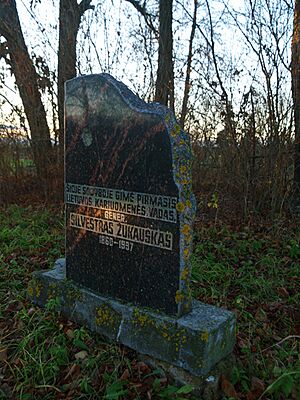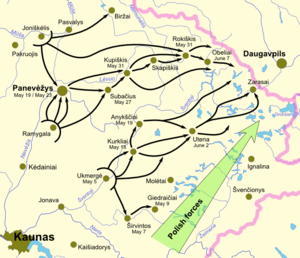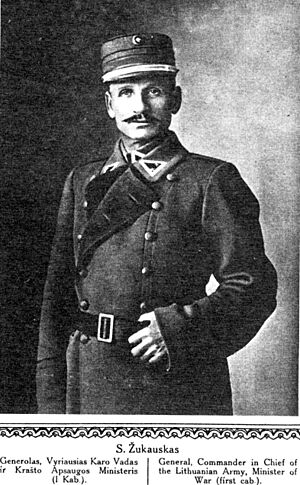Silvestras Žukauskas facts for kids
Quick facts for kids
Silvestras Žukauskas
|
|
|---|---|
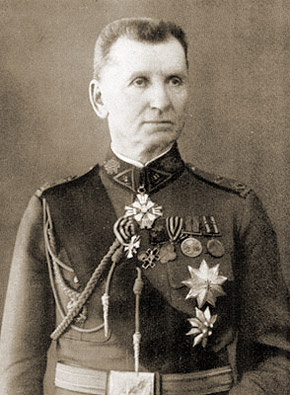
General Silvestras Žukauskas in Lithuanian uniform
|
|
| Born | 31 December 1860 Poškiečiai, Kovno Governorate, Russian Empire |
| Died | 26 November 1937 (aged 76) Ramučiai, Lithuania |
| Allegiance | |
| Service/ |
Imperial Russian Army Lithuanian Armed Forces |
| Years of service | 1881–1928 |
| Rank | General |
| Commands held | 314th Novooskolsk Infantry Regiment 1st Infantry Division Commander of the Lithuanian Army |
| Battles/wars | Russo-Japanese War First World War Lithuanian–Soviet War Polish–Lithuanian War |
Silvestras Žukauskas (born December 31, 1860 – died November 26, 1937) was an important Lithuanian General. He first served in the Imperial Russian Army. There, he showed great skill during World War I, becoming a major general.
After the war, he joined the new Lithuanian Army. He was its Chief Commander three times. These times were from May to September 1919, February to June 1920, and June 1923 to January 1928. He played a key role in Lithuania's fight for independence.
Contents
Biography
Early Life and Russian Army Service
Silvestras Žukauskas was born on December 31, 1860. His birthplace was the village of Poškiečiai near Pakruojis, Lithuania. Not much is known about his parents. People believe they were landless nobles.
He finished six grades at the Marijampolė Gymnasium. Then, he joined the Imperial Russian Army in 1881. From 1883 to 1887, he studied at the Vilnius Military School. After graduating, he was sent to the 109th Volga Infantry Regiment.
In 1900, he was promoted to captain. He was later moved to a regiment in present-day Ukraine. In 1905, he took artillery courses for officers. He was then put in charge of a machine gun company. Some reports say he fought in the Russo-Japanese War. However, his official records do not clearly show this.
In 1908, he became a podpolkovnik (lieutenant colonel). He was given command of a battalion. In 1913, he was promoted to polkovnik (colonel).
World War I
When World War I began, Žukauskas was put in charge of the new 314th Novooskolsk Infantry Regiment. He led his soldiers in battles across present-day Poland, Lithuania, and Latvia. In November 1914, he was injured in his left leg. He returned to the front in January 1915.
His regiment moved to present-day Lithuania in May 1915. They fought in the Raseiniai District Municipality. For defending Šiauliai, Žukauskas received the Saint George Sword. In April 1916, he was promoted to brigade commander. He was injured again in June 1916.
On November 21, 1916, he became a major general. In May 1917, Žukauskas was promoted to commander of the 1st Infantry Division. In February 1918, while he was on vacation, German forces captured most of his division. Žukauskas was then released from the army.
Lithuanian Wars of Independence
Fighting for Lithuania's Freedom
After leaving the Russian Army, Žukauskas returned to Lithuania. In April 1919, he became the Chief of the General Staff for the new Lithuanian Army. At this time, Lithuania was facing invading Soviet forces. These forces had taken over much of Lithuania.
Žukauskas decided to launch a major attack in northeastern Lithuania. Their first goal was to take Ukmergė, which they did on May 3. This attack was very successful. They captured many Soviet soldiers and freed Polish prisoners. On May 7, Lithuanians entered Širvintos. They worked with Polish troops to take Giedraičiai on May 9. These were the first big successful attacks by the Lithuanian Army.
On May 7, Žukauskas took command of the entire Lithuanian Army. He reorganized the forces into two main groups. These groups pushed forward, capturing towns one after another. By mid-June, the Soviets were cornered in a small area. In August, Lithuanians pushed the Soviets across the Daugava River. Žukauskas also gave out the first military awards.
Challenges in Command
On September 26, 1919, Žukauskas was removed as army commander. This happened because of concerns about his connections to Poland. He was known to speak Polish and was seen by some as being too friendly with Polish interests. There were rumors that he was involved in a plan by Polish groups. Even though Žukauskas likely didn't know about the full plan, these suspicions led to his dismissal.
He continued to serve in the General Staff. He also helped oversee the removal of German-backed forces, called the Bermontians, from the Baltic States.
Return to Command and Further Battles
In February 1920, Žukauskas was again named Chief Commander of the Lithuanian Army. This happened after some soldiers caused trouble in Kaunas. He helped calm the situation.
Later, he took a break and visited Vilnius. He wrote an article supporting a union between Lithuania and Poland. This caused more concern among Lithuanian soldiers. He then asked to retire from the army. President Smetona accepted his request in June 1920.
However, Žukauskas returned to the Lithuanian Army in August 1920. After Lithuania lost a battle against Poland, he agreed to command the armed forces again in October. In October 1920, Poland launched an attack known as Żeligowski's Mutiny. Lithuanian troops had to leave Vilnius. In November, Žukauskas led Lithuanian forces to successfully push back the Polish forces from Širvintos and Giedraičiai. The fighting stopped as other countries tried to help solve the conflict.
Despite his military skills, Žukauskas continued to face doubts about his loyalty to Lithuania. Many saw him as a good soldier but not a good politician. Because of these concerns, he was removed from command in May 1921. A month later, he officially retired from active military duty.
Later Life and Legacy
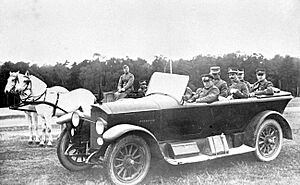
President Aleksandras Stulginskis called Žukauskas back to military service in June 1923. He served as commander of the Lithuanian Army again until January 1928. During this time of peace, he worked to improve military training and discipline. He also made sure to stay close to his soldiers.
Žukauskas supported the change in government leadership in December 1926. This change brought President Antanas Smetona to power. Žukauskas visited military units to explain the changes and keep order.
He retired for good on January 26, 1928, due to his age. The Lithuanian government gave him the Davalgoniai estate as a gift in 1927. He continued to advise military leaders and President Smetona.
Silvestras Žukauskas passed away on November 26, 1937. His funeral was a big public event. His body was displayed at the Vytautas the Great War Museum. Generals guarded his coffin, and important people gave speeches. He was buried in the Lutheran section of the Kaunas City Old Cemetery.
Remembrance
Sadly, Žukauskas's grave was destroyed in 1959. This happened when the Soviet authorities turned the Kaunas City Old Cemetery into a park. Even with searches in 2012, his original grave was never found.
Commands
Žukauskas held several important commands in the Lithuanian Army:
- Chief of the General Staff
- April 26 – May 27, 1919
- Chief Commander of the Lithuanian Army
- May 7 – September 26, 1919
- February 23 – June 14, 1920
- June 6, 1923 – January 26, 1928
- Commander of the Armed Forces
- October 1, 1920 – May 29, 1921
Awards
Žukauskas received many awards for his service:
- 1889: Order of Saint Stanislaus, 3rd class
- 1889: Order of Saint Anna, 3rd class
- 1905: Order of Saint Stanislaus, 2nd class
- 1912: Order of Saint Anna, 2nd class
- 1914: Order of Saint Vladimir, 4th class
- 1915: Order of Saint Vladimir, 3rd class
- 1915: Order of Saint Anna, 4th class
- 1915: Saint George Sword (for defending Šiauliai)
- 1919: Order of the Cross of Vytis, 4th and 5th degree
- 1926: Czechoslovak War Cross 1918
- 1927: Order of the Cross of Vytis, 1st degree
- 1927: Order of the Lithuanian Grand Duke Gediminas, 1st degree
- 1929: Order of Lāčplēsis, 2nd class


